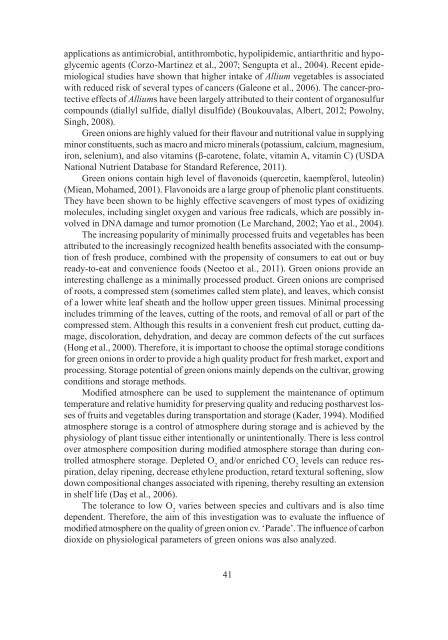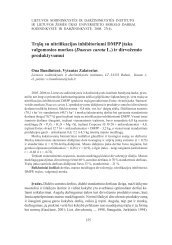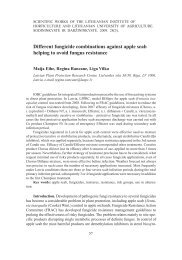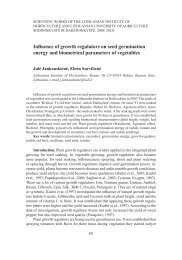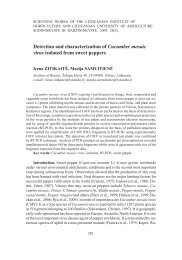31(1–2) - Sodininkystė ir daržininkystė - Sodininkystės ir ...
31(1–2) - Sodininkystė ir daržininkystė - Sodininkystės ir ...
31(1–2) - Sodininkystė ir daržininkystė - Sodininkystės ir ...
Create successful ePaper yourself
Turn your PDF publications into a flip-book with our unique Google optimized e-Paper software.
applications as antimicrobial, antithrombotic, hypolipidemic, antiarthritic and hypoglycemicagents (Corzo-Martinez et al., 2007; Sengupta et al., 2004). Recent epidemiologicalstudies have shown that higher intake of Allium vegetables is associatedwith reduced risk of several types of cancers (Galeone et al., 2006). The cancer-protectiveeffects of Alliums have been largely attributed to the<strong>ir</strong> content of organosulfurcompounds (diallyl sulfide, diallyl disulfide) (Boukouvalas, Albert, 2012; Powolny,Singh, 2008).Green onions are highly valued for the<strong>ir</strong> flavour and nutritional value in supplyingminor constituents, such as macro and micro minerals (potassium, calcium, magnesium,<strong>ir</strong>on, selenium), and also vitamins (β-carotene, folate, vitamin A, vitamin C) (USDANational Nutrient Database for Standard Reference, 2011).Green onions contain high level of flavonoids (quercetin, kaempferol, luteolin)(Miean, Mohamed, 2001). Flavonoids are a large group of phenolic plant constituents.They have been shown to be highly effective scavengers of most types of oxidizingmolecules, including singlet oxygen and various free radicals, which are possibly involvedin DNA damage and tumor promotion (Le Marchand, 2002; Yao et al., 2004).The increasing popularity of minimally processed fruits and vegetables has beenattributed to the increasingly recognized health benefits associated with the consumptionof fresh produce, combined with the propensity of consumers to eat out or buyready-to-eat and convenience foods (Neetoo et al., 2011). Green onions provide aninteresting challenge as a minimally processed product. Green onions are comprisedof roots, a compressed stem (sometimes called stem plate), and leaves, which consistof a lower white leaf sheath and the hollow upper green tissues. Minimal processingincludes trimming of the leaves, cutting of the roots, and removal of all or part of thecompressed stem. Although this results in a convenient fresh cut product, cutting damage,discoloration, dehydration, and decay are common defects of the cut surfaces(Hong et al., 2000). Therefore, it is important to choose the optimal storage conditionsfor green onions in order to provide a high quality product for fresh market, export andprocessing. Storage potential of green onions mainly depends on the cultivar, growingconditions and storage methods.Modified atmosphere can be used to supplement the maintenance of optimumtemperature and relative humidity for preserving quality and reducing postharvest lossesof fruits and vegetables during transportation and storage (Kader, 1994). Modifiedatmosphere storage is a control of atmosphere during storage and is achieved by thephysiology of plant tissue either intentionally or unintentionally. There is less controlover atmosphere composition during modified atmosphere storage than during controlledatmosphere storage. Depleted O 2and/or enriched CO 2levels can reduce resp<strong>ir</strong>ation,delay ripening, decrease ethylene production, retard textural softening, slowdown compositional changes associated with ripening, thereby resulting an extensionin shelf life (Daş et al., 2006).The tolerance to low O 2varies between species and cultivars and is also timedependent. Therefore, the aim of this investigation was to evaluate the influence ofmodified atmosphere on the quality of green onion cv. ‘Parade’. The influence of carbondioxide on physiological parameters of green onions was also analyzed.41


